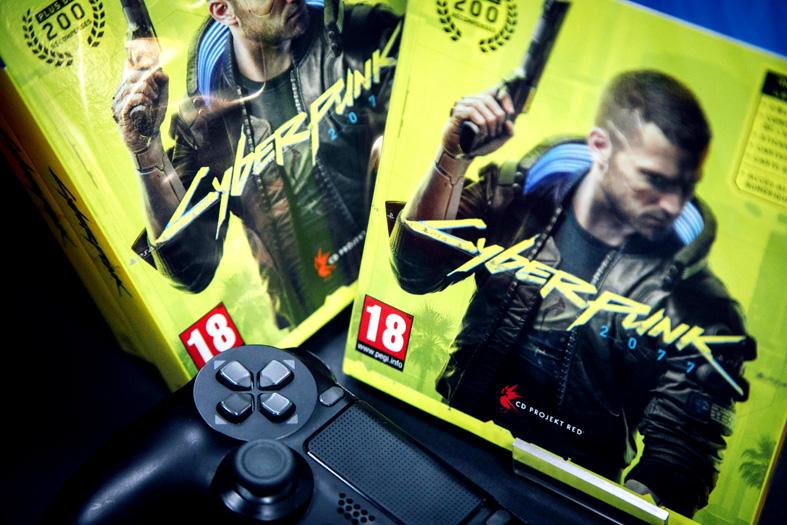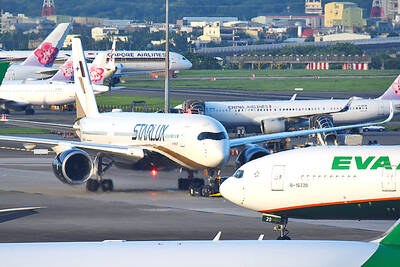Retro-futurist video game Cyberpunk 2077 is to be back in the PlayStation Store tomorrow after a disastrous launch marred by bugs forced a 184-day time-out on the platform, but can a blockbuster game recover from the reputational hit of a failed rollout? Sometimes, as other titles have shown, one can.
“Redemption is possible, but it’s risky. Fail twice and you’re done,” said Yohan Bensemhoun, game tester for jeuxvideo.com.
CD Projekt Red SA’s dark future roleplaying title had been hotly anticipated after the studio’s work on the groundbreaking The Witcher 3: Wild Hunt, but gamers were disappointed when the game first appeared and an online storm damaged confidence.

Photo: Bloomberg
Some games — even some studios — go under after such a botched start, but when the hopefully revamped Cyberpunk 2077 goes back on sale the developers will be hoping they emulate the revival of games like No Man’s Sky.
When that game came out in mid-2016, under the banner of UK studio Hello Games, the epic space explorer was billed as a revolution, set in an almost infinite universe featuring planets boasting unique ecosystems.
“It’s up there, yes, as one of the most exciting game I’ve ever awaited,” 31-year-old British gamer Matthew Winter said.
However, the resulting game fell short as repetitive and bug-ridden. A social media furore erupted among the vocal gaming community.
“I was very disappointed,” Winter said. “I blame them for lying but I blame myself for allowing myself for being as hyped as I was.”
Many players demanded refunds, but five years later No Man’s Sky has not only survived, but — after a series of free downloadable fixes and improvements — it has become a critical success and something of a classic.
Reinvention and constant updates are even more important in the world of the massively multiplayer online role-playing game which relies on a loyal subscriber base to maintain longer-term revenue.
In 2010, Japanese studio Square Enix Holdings Co’s Final Fantasy XIV — as the number implies — inherited fans from a popular long-running series, only to disappoint them at first with a lack of varied content within the players’ world.
The first version was taken down and a relaunched, reworked virtual world returned in 2013. Bit by bit the community was restored, and by the middle of last year 20 million players were wandering its vast playable space.
The huge user base becomes not only the strength of a game and the source of its profits, but also a powerful incentive not to just abandon a struggling title, but to rework it over time to iron out problems, journalist Daniel Andreyev said.
Sometimes, it is not a technical failure that sinks a game, but a perceived betrayal.
In 2017, US publisher Electronic Arts Inc (EA) brought out Star Wars Battlefront II, a title that could rely on the goodwill of fans of both the iconic space opera franchise and a series of popular and accomplished battle games.
The problem was in the way players progressed in the game, with their digital avatars gaining prowess through “loot boxes”: caches of virtual weapons and equipment to help them overcome increasingly dangerous foes.
These boxes could be acquired through spending time in the game at the frontline — or paying real-world money to unlock them.
This was not a new concept, but it was not popular with fans. The Force was not with EA, and after months of online abuse the company dropped the in-game commerce and attempted to win back customers by adding new, fan-friendly Star Wars content such as classic characters and locations.
“We got it wrong,” former EA executive Patrick Soderlund told The Verge in 2018. “I’d be lying to you if I said that what’s happened with Battlefront and what’s happened with everything surrounding loot boxes and these things haven’t had an effect on EA as a company and an effect on us as management.”

Taiwan’s rapidly aging population is fueling a sharp increase in homes occupied solely by elderly people, a trend that is reshaping the nation’s housing market and social fabric, real-estate brokers said yesterday. About 850,000 residences were occupied by elderly people in the first quarter, including 655,000 that housed only one resident, the Ministry of the Interior said. The figures have nearly doubled from a decade earlier, Great Home Realty Co (大家房屋) said, as people aged 65 and older now make up 20.8 percent of the population. “The so-called silver tsunami represents more than just a demographic shift — it could fundamentally redefine the

The US government on Wednesday sanctioned more than two dozen companies in China, Turkey and the United Arab Emirates, including offshoots of a US chip firm, accusing the businesses of providing illicit support to Iran’s military or proxies. The US Department of Commerce included two subsidiaries of US-based chip distributor Arrow Electronics Inc (艾睿電子) on its so-called entity list published on the federal register for facilitating purchases by Iran’s proxies of US tech. Arrow spokesman John Hourigan said that the subsidiaries have been operating in full compliance with US export control regulations and his company is discussing with the US Bureau of

Businesses across the global semiconductor supply chain are bracing themselves for disruptions from an escalating trade war, after China imposed curbs on rare earth mineral exports and the US responded with additional tariffs and restrictions on software sales to the Asian nation. China’s restrictions, the most targeted move yet to limit supplies of rare earth materials, represent the first major attempt by Beijing to exercise long-arm jurisdiction over foreign companies to target the semiconductor industry, threatening to stall the chips powering the artificial intelligence (AI) boom. They prompted US President Donald Trump on Friday to announce that he would impose an additional

China Airlines Ltd (CAL, 中華航空) said it expects peak season effects in the fourth quarter to continue to boost demand for passenger flights and cargo services, after reporting its second-highest-ever September sales on Monday. The carrier said it posted NT$15.88 billion (US$517 million) in consolidated sales last month, trailing only September last year’s NT$16.01 billion. Last month, CAL generated NT$8.77 billion from its passenger flights and NT$5.37 billion from cargo services, it said. In the first nine months of this year, the carrier posted NT$154.93 billion in cumulative sales, up 2.62 percent from a year earlier, marking the second-highest level for the January-September